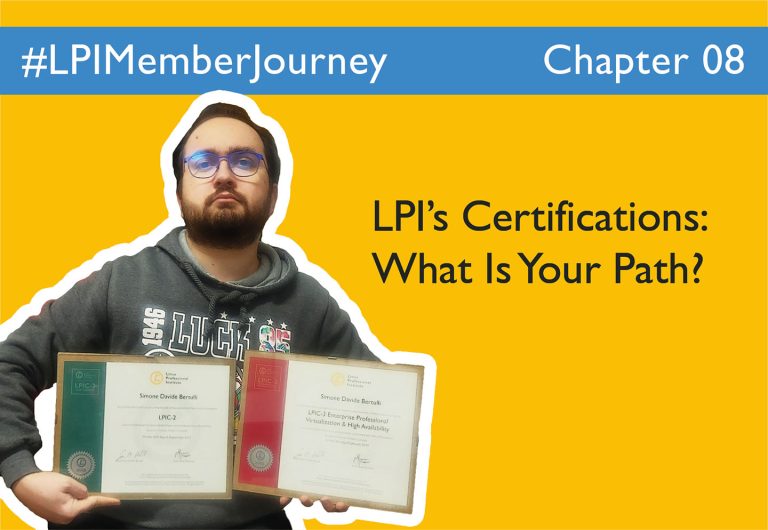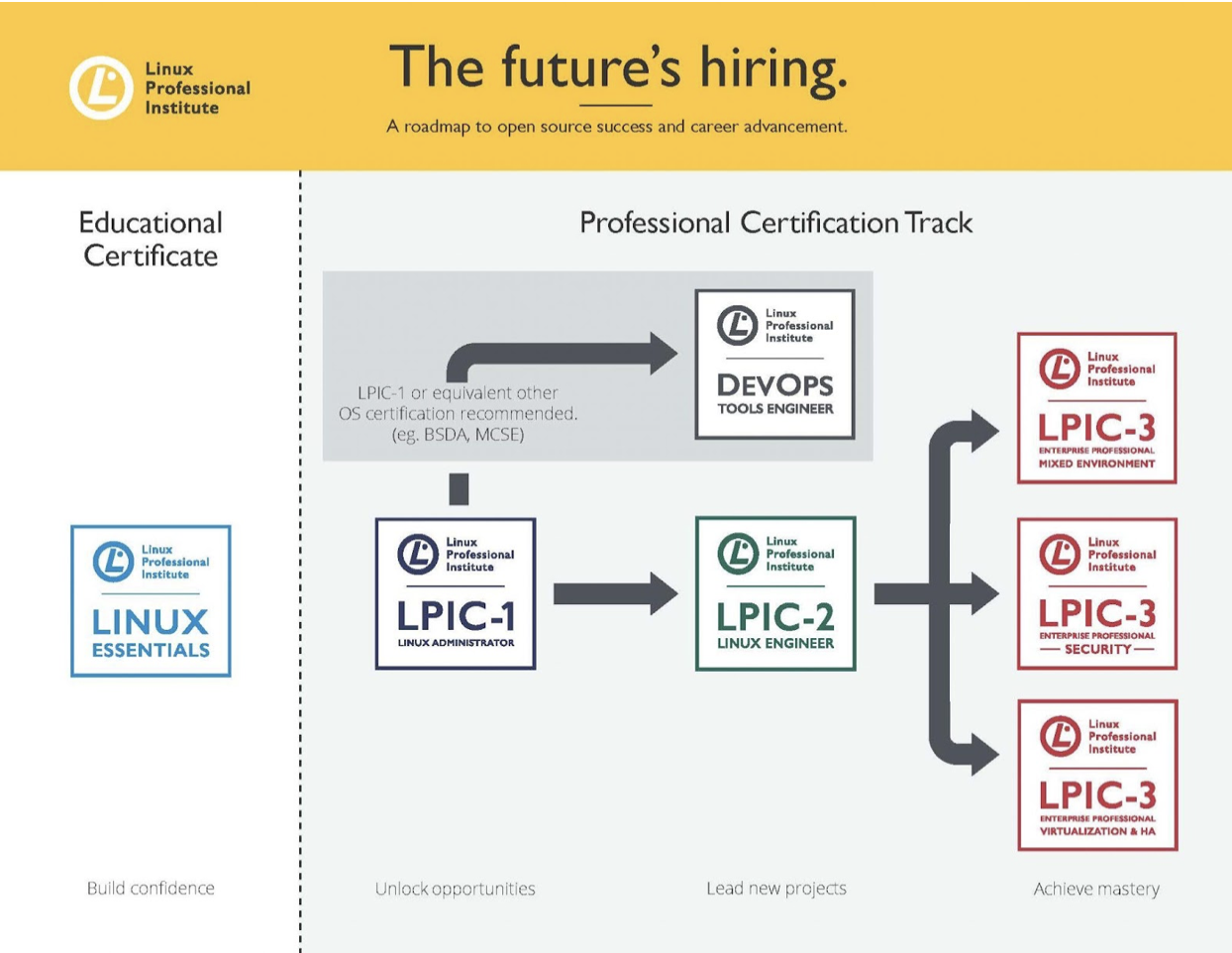Simone “Simo” Bertulli: LPI’s Certifications – What Is Your Path?

In this post I will do something different from the previous ones: I will be matching the LPI’s certifications panel with specific job descriptions and career paths.
LPI offers technical certifications for every level of training and on different subjects. Each certification aims at a specific objective and groups together topics that best prepare people with the skills they need to apply the technology at work.
The LPI certification program is a smooth, well-run framework. OK: I am slightly biased, here…
But I do believe that, to exploit each of these certifications entirely, it is helpful to think about them, to approach them, in terms of professional paths, paths that are not necessarily linked to aiming for the highest step of specialization, but to consolidate your knowledge in a specific area of interest or application.
Your career’s colors
In other words: the certifications, as a whole, are a palette: it’s you who is going to choose the best colors for your painting, your career.
Hence, I would not say that there is only “the one” path that is necessarily the best, but that there are many, the best fit being the one with the specific skills required by the work market for one particular role.
Another good reason this approach can be helpful is that there is never just “the one” technology in the open-source world to which we have to refer, to deal with, to work on.
With a set of technologies and tasks in mind, having a path as defined or structured as possible allows you to create very well consolidated and, therefore, more “vertical” skill sets, focusing on the quality of training on them.
Begin from the beginning
Generally speaking, the starting point is the Linux Essentials https://www.lpi.org/our-certifications/linux-essentials-overview certification and the first step of the professional path, the LPIC-1 certification https://www.lpi.org/our-certifications/lpic-1-overview, to get the basics of system and network administration.
I also strongly recommend the BSD Specialist https://www.lpi.org/it/our-certifications/bsd-overview certification, as it is very similar to the LPIC-1 one in terms of competence and knowledge covered, but with a few important differences.
Differences because, after all, we are talking about diverse ecosystems from a technical point of view. In my opinion the LPIC-1 and the BSD Specialist certifications aren’t interchangeable (given the “verticality” of the different operating systems ). This is why they must be evaluated in a global view of their complementarity, within the broad Open Source universe.
I wanted to consider Linux Essentials as the starting point just to remind everybody how important small steps are at the beginning of a long journey ;-).
Below, we see the roadmap of certifications as proposed by LPI itself:

Following what we can see above, I will share with you my personal opinion about how an IT professional can “play”, with the roadmap, as from my own experiences at work and analyzing how certifications play their role in multiple environments.
Path #1: Linux Essentials + LPIC-1 + BSD Specialist
Position: Junior Sysadmin.
The Junior Sysadmin title can be associated with several job titles, such as “Unix Administrator”, “Server Administrator”, or “IT Administrator”. Sometimes, with technical support or help desk too.
This first path aims to give solid knowledge to start working in the Linux / Open Source world, thus allowing certified people to be able to cover the following roles in various operating environments:
- Technical Support / Help Desk
- Unix Administrator
- Server Administrator
- IT Administrator

Path #2: Linux Essentials + BSD Specialist + LPIC-1 + LPIC-2
Position: Advanced level help desk – Senior Sysadmin.
“Senior” level system administrator with more in-depth skills, such as being able also to be a network engineer of a Network Operation Center (NOC). This level also corresponds to an advanced level help desk qualification.
Compared to the #1path, the LPIC-2 step is added, to consolidate system knowledge previously acquired with other skills such as the management of e-mail servers, DNS, file sharing, insights on some security elements and much more; in the networking field, management of switches, routers and other network devices that use hardened versions of Linux or BSD as operating systems.

Path #3: Linux Essentials + BSD Specialist + LPIC-1 + LPIC-2 + LPIC-3 Mixed
Position: Sysadmin specialist.
A professional who has the skills to be able to work both as a systems engineer and as an advanced level network engineer; in short, this is the training path for the “definitive system engineer” 🙂
The LPIC-3 Mixed Environment https://www.lpi.org/our-certifications/lpic-3-300-overview, in this case, consolidates the high-end Linux systems skills taking into consideration the integration between a number of operating systems with all the relative features, such as LDAP configuration issues, SAMBA, Active management Directory, management of Windows clients and related file systems in mixed, complex and structured environments.

Path #4: Linux Essentials + BSD Specialist + LPIC-1 + LPIC-2 + LPIC-3 Security
Position: Security specialist.
This is a very crucial role, in high demand because it is difficult to get security right, and security resources are generally limited.
The path inherent in IT security notoriously has to cover large macro-areas: I strongly recommend here both the specialist certifications, including LPIC-3 Mixed Environment https://www.lpi.org/our-certifications/lpic-3-300-overview as it deals with the interaction with other operating systems.
LPIC-3 Security https://www.lpi.org/our-certifications/lpic-3-303-overview, of course, will cover all the aspects of the complex IT security world, leaving the certified professional with a good understanding of the right modus operandi.

Path #5: Linux Essentials + BSD Specialist + LPIC-1 + LPIC-2 + LPIC-3 Virtualization + DevOps
Position: Cloud specialist.
This position is required as an internal resource in many companies, and to manage third-party cloud providers as well. In such working environments, skills in DevOps and CI / CD are in play too.
The demand for experienced and suitably trained personnel on cloud technologies is always very high, given the great benefits that this method of providing services brings with itself.
In this case, the LPIC-3 Virtualization and Containerization certification https://www.lpi.org/our-certifications/lpic-3-305-overview is a “must-have” to begin to understand this world which is as complex as it is fascinating; the DevOps Tools Engineer https://www.lpi.org/our-certifications/devops-overview certification covers very useful and interesting topics such as the various Cloud techniques, Machine Deployment & Orchestration, the phases of Service Operations, Container Deployment and much more.

Path #5 plus: how to go even further
In this case, however, we can open up two even more specialized routes, since as we now know, the 304 virtualization and high-reliability exam has been split into two exams:
- LPIC-3 Virtualization and Containerization 3.0 (exam 305) https://www.lpi.org/our-certifications/lpic-3-305-overview
- LPIC-3 High Availability and Storage Clusters 3.0 (exam 306) https://www.lpi.org/our-certifications/lpic-3-306-overview
Exam 305 covers the whole area of virtual machines, containers, and the relative orchestration tools, with all the existing technologies being addressed.
Exam 306, on the other hand, deals with the topics of high reliability, management of clusters, and resources distributed over several computing nodes, passing through topics such as storage and file systems in distributed environments.
It totally makes sense to have two separate exams, as just one exam cannot cover in a detailed and exhaustive manner all the technical matters related to virtualization and high reliability.
To become a specialist of the field you have to segment and investigate clusters of closely related topics. I have taken the 304 exam in 2019, I can say in no uncertain terms how much the certified skills and knowledge match the actual work in the field.
An example? The virtualization and high reliability topics are intended for an audience of systems engineers, but it is related to containers too, and everything about this cluster of topics is of interest for the DevOps universe, building a sort of virtual bridge between certifications.
This ultimate path, as, of course, the previous ones for different positions and careers, stresses exactly what I try to achieve for my professional development: grasping the possibility of “verticalization” of skills and competence, enriching your curriculum with an extra qualification. Something that people looking for continuous improvement definitely love 🙂
